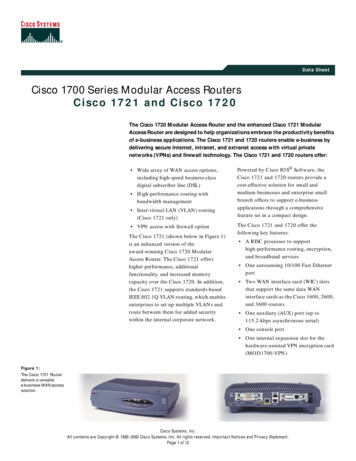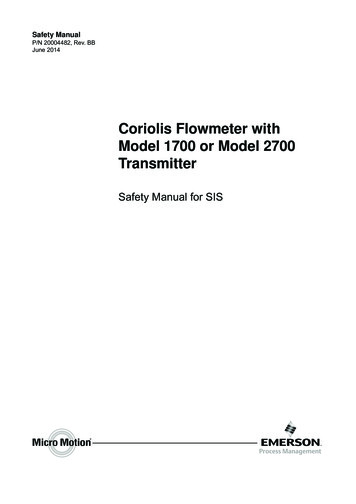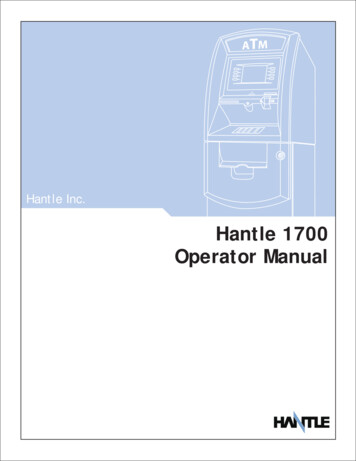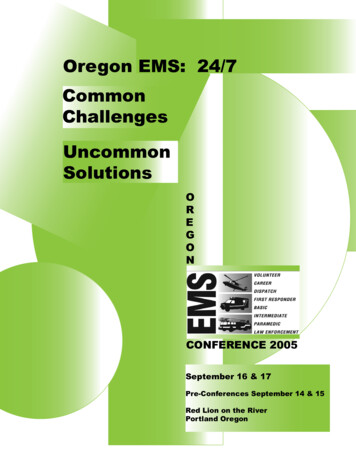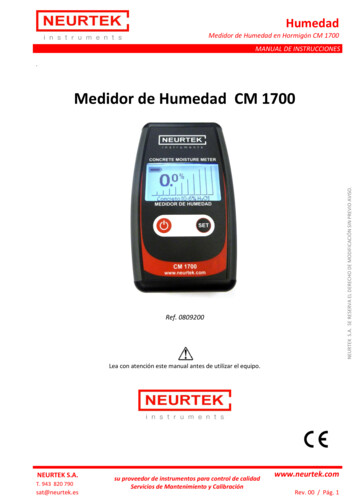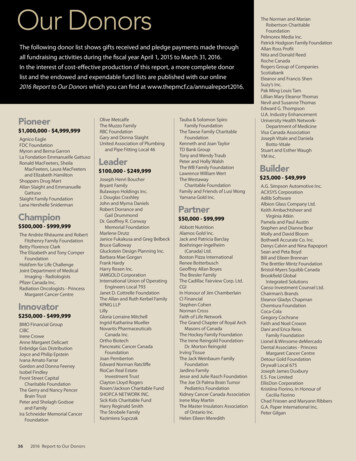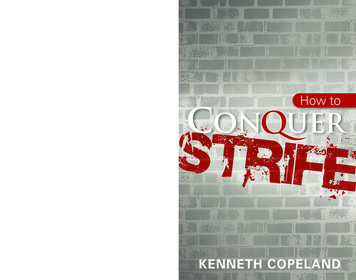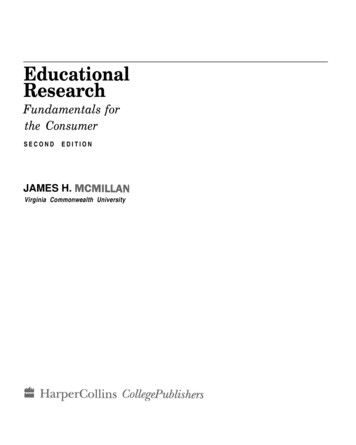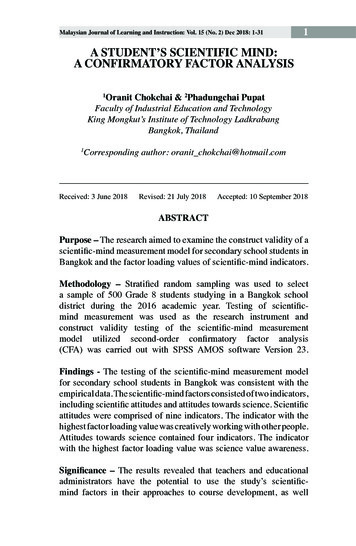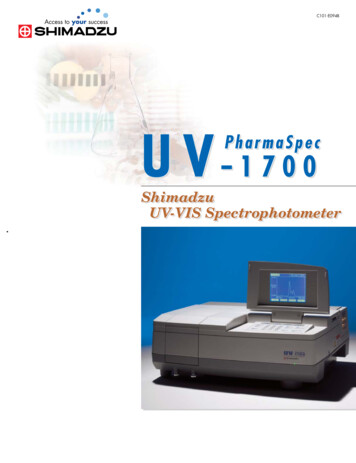
Transcription
C101-E094BU V-1 700PharmaSpecShimadzuUV-VIS Spectrophotometer
World-leading1nmWorld-leading1nm resolutionresolution isisthethe bestbest inin itsits classclassU V-17 0 0P h a r m a S p e c Specifications (wavelength accuracy, resolution, photometric accuracy,etc.) and functions conform to the European, US, and Japanesepharmacopoeias. Hardware validation (9 items) as standard. Supports IQ/OQ * Compact design 17 kg lightweight model can be easily moved by a single person. Simple operation with specialized function keys.Ease of operation via clear interactive LCD display. Comprehensive functions for quantitative and qualitative analysisinstalled as standard can be extended using IC cards.PC-compatibility using latest Windows software. Multi wavelength photometricmeasurement mode is standard.* IQ/OQ contains the following details that are checked and recorded at the timethe equipment is installed. They are extremely important documents forcompliance with FDA guidelines.1.IQ (Installation Qualification)Confirms that the instrument has been properly installed in the originalconfiguration and in an appropriate environment.2.OQ (Operational Qualification)Confirms that the instrument has achieved the original target performance.2
BenefitsBenefits ofof 1nm1nm resolutionresolutionSubstances containing benzene rings exhibit sharpabsorption bands near 250 nm. In such cases, a 1 nmdifference in resolution is clearly apparent. The diagramabove shows the spectra of an ethanol solution ofbenzene obtained with the UV-1700 and a previousinstrument with a 2 nm resolution (bandwidth). Thediagram confirms a maximum 40% difference due to thedifferent resolutions. (Diagram displayed using theUVProbe PC software.)The UV-1700 comfortably clears the wavelengthresolution standard prescribed in the EuropeanPharmacopoeia. The European Pharmacopoeia demandsa ratio exceeding 1.5 between the peak value near 269nm and valley value near 266 nm for a toluene solution inhexane. This ratio is 2.23 in the diagram above obtainedwith the UV-1700. (Diagram displayed using theUVProbe PC software.)Wavelength(nm)The wavelength accuracy check is conducted using optical wavelength accuracy check filters.(The diagram shows the spectrum and peak-detection results for an NIST standard holomiumsolution SRM2034 for wavelength calibration.)3
UV-1700PharmaSpecFrom photometric to multi-component quantitation,almost all of the functions required in the lab are built in.SpectrumA samples spectrum is recorded usingwavelength scanning. Repeat scans let youfollow sample changes over time. Zoom in on thefinished spectrum for a better view, and then usethe peak/valley pick function to select maximaamd minima, and perform a wide variety of dataprocessing functions.KineticsMeasure absorbance changes as a function oftime, and obtain the enzymatic activity value.Select among single wavelength, multicell,double wavelength and rate measurementmethods. Using the MMC-1600/1600C (8/16cells) or the CPS-240A Cell Positioner (6 cells),multiple samples can be measured at the sametime.QuantitationGenerates a calibration curve from measurementof standards, and then calculates theconcentrations of unknowns. Allows variouscombinations of wavelength number (1 to 3wavelengths, peak area values) and calibrationcurves (K factor, 1st to 3rd order).Time Course ScanMeasures the changes in absorbance,transmittance or energy as a function of time.Using the MMC-1600/1600C (8/16 cells) or theCPS-240A Cell Positioner (6 cells), multiplesamples can be measured at the same time.Multi-Component QuantitationQuantitates up to 8 components mixed in a singlesample. The calibration equation is determinedusing pure or mixed components with knownvalues.Optional Application ProgramsMulti Wavelength MeasurementMeasure the absorbance and transmittance atup to eight designated wavelengths. Forabsorbance measurements, calculation of datafor up to four wavelengths, including thedifference or ratio between two wavelengths, ispossible.In seconds, the easy-to-insert program packsreconfigure the UV-1601 for specific laboratoryprotocols.Instrument ConditionsThe basic instrument conditions can be set toaccommodate the method of use for even greaterconvenience. And, built-in self-performancecheck functions ensure the continued reliability ofmeasurement data.4
Wavelength repeatability and other automatic testfunctions are built-in, providing easy compliance withGLP and ISO-9000 requirements.PhotometricsMeasures absorbance or transmittance at awavelength of your choice. By connecting anoptional multicell sample compartment, up 16samples can be measured continuously (whenusing MMC-1600/1600C and 16-cell micromulticell). And, data may be conveniently storedon IC cards.PC ControlThe built-in RS-232C allows connection betweenthe UV-1700 and your PC, permitting full controlfrom the PC, automatic system configuration,data exchange, and an expanded array of dataprocessing functions.MaintenanceThe maintenance functions include an indicationof the date and time of the previous baselinecorrection, confirmation of lamp usage time, andunit validation.IC CardsParameter RecallThe measurement mode and its parameters canbe stored in memory or on IC cards, available forrecall and setting at any time. Operation is easyand there is less possibility of making settingerrors.Special IC cards greatly extend the functionalityof the UV-1700 system. IC card utilities allowdata pack copying, IC card initialization, andother functions.5
UV-1700PharmaSpecFrom transparent samples to samples with suspended andcomponents, they can all be measured and quantitated. Evenvolume and enzyme activity measurements are possible.1.Micro Volume Sample Measurement3uL capillary cells and 50µL ultramicro cells are availablefor measurement of minute volumes of sample. The spectrain the first figure were obtained from measurement of DNAin herring sperm in phosphate buffer solution. (A 3µrcapillary cell was used.) Even though measurement wasconducted in the ultraviolet region, the light beam wascondensed sufficiently to provide a spectrum with a highsignal-to-noise ratio. The second figure shows the linearityof the calibration curve.2.Multicell Kinetic MeasurementMulticell kinetics measurement can be performed using atemperature controlled cell positioner. At right, the enzymeactivity of cholinesterase in blood serum was measured.Enzyme reactions can be measured in up to 16 cells at onetime.6
interferingmicro3.Multi Wavelength MeasurementMeasures the absorbance or transmittance for a sample atup to eight selected wavelengths. When absorbance ismeasured, results can be displayed or output by calculatingdata using up to four wavelengths.Note : If a printer is connected, results are printed after each measurement.(The data cannot be saved for individual measurements.)4.Multi-component AnalysisQuantitative analysis can be performed for up to 8components mixed in a single sample. At right, aspirin,caffeine and salicylic acid were present in a sample in ratiosof 2 : 1 : 1, as confirmed in the separated quantitationresult.The second figure shows the spectral characteristics of thethree ingredients and the mixture. Note the distinctlydifferent spectral characteristics, allowing the variouscompounds to be distinguished.Mixture sampleAspirinSalicylic acidCaffeine7
UV-17005.PharmaSpecInstrument Validation FunctionsThese functions can conduct performance checks(measurement, pass/fail evaluation and printing) for nineitems, including wavelength accuracy.Validation is divided into fully automatic checks, where allprocedures from measurement to evaluation are automaticallycompleted, and semi-automatic checks, where the insertionand removal of inspection jigs are required.The semi-automatic checks are performed interactively. Theuser can conduct the validation by inserting or removinginspection jigs as instructed by messages on the screen.The control numbers and expiration date of the inspection jigscan be entered in the inspection conditions. The expirationdate is automatically checked at the start of the test and thevalidation is discontinued if a jig is past its expiration date.8
Printing ExamplesValidation results can be printed out if a printer is connected. The two printed forms available are the detailed results form thatshows the spectrum and time-course data (curves) and results for each test, and the general results form that lists the results for allselected validation items after they are complete. Detailed results form 6. General Results form MaintenanceThe lamp usage times for the deuterium (D2) and halogen(WI) lamps are counted. The lamp usage time is displayedduring periodic maintenance to determine when the lampsneed to be replaced.9
UV-1700PharmaSpecSpectrophotometer Specifications (UV-1700)ItemSpecificationItemSpecification 0.002 Abs (at 1.0 Abs)Spectral bandwidth1 nm (190 to 900 nm)Dimensions550W 470D 200 H (mm) (max. height 380 mm)Weight17 kgBaseline stability0.001 Abs/h max (700 nm, After 1hour from power on)Wavelength range190.0 to 1100.0 nmBaseline flatness 0.001 Abs (1100 mm to 200 mm) After 1hour from power onWavelength display0.1 nm incrementsNoise levelWavelength settingPhotometric repeatability0.1 nm increments (1 nm increments whenBaseline correctionsetting scan range)Wavelength accuracy 0.001 Abs (at 0.5 Abs)0.002 Abs (P-P) 0.0002 A (RMS) (700nm)Automatic with computer memory, in twostages of coarse and fine 0.3 nmLight sourceWavelength repeatability 0.1 nm20 W halogen lamp, deuterium lampBuilt-in light source automatic position adjustmentWavelength slew speed: Approx. 6000 nm/minWavelength Scan Rates Wavelength scanning speed: Approx. 3000MonochromatorAberration-corrected blazed holographic gratingDetectorSilicone photodiodeInternal dimensions: 110.0W 230.0D 105.0H (mm)nm/min to 10 nm/minLamp interchange wavelength 295.0 nm to 364.0 nm (340.8 nm)Sample compartmentDistance between light beams: 100.00 mmStray light0.04% max. (220.0 nm NaI, 340.0 nm NaNO2)Installation: Fixed with two screwsPhotometric systemDouble-beam OpticsBeam size: 9 x 0.5 mmPhotometric rangeAbsorbance: -0.5 to 3.0 AbsPower requirementsTransmittance: 0.0 to 300%Recording range100, 120, 220, 240 VAC50/60 Hz, 130 VAAmbient requirementsAbsorbance: -3.99 to 3.99 AbsTemperature: 15 to 35 C, humidity: 35 to 80%Transmittance: -399 to 399%Photometric accuracy 0.004 Abs (at 1.0 Abs), using NIST930D filter 0.002 Abs (at 0.5 Abs)Overall Dimensions (UV-1700)200470Max380550470Units: mm10
UV-1700 Software SpecificationsMeasurement eticsModeSpecifications1 Measurement at user-selected fixed wavelength2 Quantitation using K-factor method3 Photometric modes: Choice of T% and Abs4 Data table storage and recall functions5 Automatic data printout1 Measurement modes: Abs, T%, EScanning range: 190.0 to 1100.0 nmOrdinate range: Abs : -3.99 to 3.99 AbsT%, E : -399 to 399%Scanning speed: Very Fast, Fast, Medium, Slow, andVery SlowNumber of repeat scans: 1 to 99Recording system: Selection between single spectrumand data overlay2 Data processingPeak/valley detection (up to 20 of each)Area calculationArithmetic operations between dataArithmetic operations between data and constants1st to 4th derivative/smoothingPoint pickData storage and recall(up to 6 in main memory, 27 in data pack)Data outputGraph axis range changeData readout at cursor-specified point3 Data export via RS-232C port1 Measurement methodsChoice of 1-wavelength, 2-wavelength, 3-wavelength,1st to 4th derivative methods2 Quantitation methodsAutomatic concentration calculation by K-factorAutomatic concentration calculation using single-pointcalibration curve or multi-point calibration curvemethod (1st to 3rd order regression curves)3 Measurement parametersNumber of repeat measurements: 1 to 9, to obtain a meanvalue for quantitationOrder of derivatives: 1st to 4thNumber of standards for multi-point calibration curve: 2 to 10Order of calibration curve: 1st to 3rdChoice of zero or non-zero intercept4 Data table storage and recall5 Automatic data printout1 Measures absorbance changes as a function of time andcalculates the enzymatic activity values.Measurement time: 1 to 6500 sec/min2 Measurement method: 1-wavelength, 2-wavelength,multicell and rate measurements3 Supports Cell Positioner CPS-240A, MulticellHolder and Sipper 1604 Data processingRecalculationGraph axis range changeData table displayData storage and recall5 Data export via RS-232C portMeasurement modeSpecificationsTime Scan1 Measurement mode: Abs, T%, EMeasurement time: 1 to 6500 sec/min2 Supports Cell Positioner CPS-240A, 6-cell MulticellSample Compartment, MMC-1600/1600C and Sippers3 Measures changes in Abs, T%, or energy over time4 Data processing: Identical to Spectrum Mode5 Data export via RS-232C port1 Up to eight components quantified at once.2 A mixture, as well as pure components, can be used asMulti-Componenta standard.3Data on standards can be stored, in addition toQuantitationmeasurement wavelengths.4 Quantitation of recalled spectrum data.1 Measurements at up to eight designated wavelengths (setin 0.1 nm increments)2 Data calculation at up to four wavelengths (differenceMulti Wavelengthor ratio between two wavelengths, calculation betweenthree wavelength, etc.) possible.Measurement3 Photometric mode: Abs, T%4 Results can be printed after each measurement. (The datacannot be saved for Individual measurements.)MaintenanceSharedFunctions1 Baseline correction2 Lamp usage time display and reset3 Instrument validation functions1) Compatible with 9 JIS itemsWavelength accuracy, wavelength repeatability,resolution, stray light, photometric accuracy, photometricrepeatability, baseline flatness, baseline stability, noiselevel, initialization result recording2) Semi-automatic validationValidation inspections conducted interactively whileinserting and removing inspection jigs.3) Fully automatic validationAutomatic validation inspections from measurement toevaluation and printout.4) Setting inspection parameters and pass/fail criteriaAuthority to make changes can be protected by password access.5) Bulk printout of resultsResults of the previous validation inspection are printedin list form. (The results of the previous inspection arecleared when another inspection is started.)1 Automatic setting of measurment mode after instrumentinitializationDesignation of a parameter file is possible.2 Backup of previous measurement parameters3 Selection of displayed number of decimal placesAbsorbance: 3 or 4 decimal placesTransmittance: 3 or 4 decimal places4 ON/OFF of the beep function5 Number of files that can be saved:Measurement parameters: 16 files max.Data: 6 files max.6 Screen hard copy printout (when a printer is connected)Date stamping can be selected between ON and OFF.7 PC controlSpectrophotometer can be controlled by an external PC(via RS-2332C).The optional UVProbe software controls this instrument.11
UV-1700PharmaSpecACCESSORIESUVProbe Software(Cat. No. 206-89456-91)UVProbe is software to control the UV-1700 from a PC. Theall-in-one software package includes spectrum, photometric(quantitation), kinetics (time course), and report generatorfunctions.An RS-232C cable is required to connect the UV-1700 to the PC.Required and recommended PC configuration for runningUVProbe is as follows: PC with Pentium (200MHz) or better processor, or 100% compatible.(Pentium II (300MHz) recommended) 64MB RAM, 128MB recommended 50MB available hard disk capacity SVGA video monitor, 800 600 dot screen resolution (1024 768recommended) Parallel and serial ports Graphic printer, or plotter ( recommended for printing data) Mouse or similar pointing device CD-ROM driveEven with the above configuration, UVProbe operating performance cannot beguaranteed, depending on Windows settings, hardware state, etc.Use Shimadzu recommended equipment, if possible.Loaded with DataProcessing/Calculation FunctionsPeak detection, Point Pick, area calculation, and many moreUVProbe includes all the data processing functions you'll need forspectrum and time course data. A variety of calculations are alsoyours for the choosing, like integration and interpolationconversions, and arithmetic operations between data.GLP/GMP CompliantFor example, when data processing is performed, the resultant data is storedtogether in the same file with the original data, which remains intact.The audit trail function tracks the instrument history, and security functions,such as the limiting of individual users to specific types of softwareoperations, ensuring full GLP/GMP compliance.Powerful Quantitation FunctionsThe Photometrics module permits multi wavelength andsingle wavelength quantitation, and quantitation based onpeaks as well as area values.Calibration curves can be generated using K factor, single ormulti point methods.Further, customized functions can be created to determinepass/fail of measurement results.12
Totally Customized ReportsArrange graphs and data just as you wish to create informative, easy-toread reports. Freely specify line thickness and font color and size, and placelabels wherever you like on graphs.Because the setup is all in WYSIWYG format, layouts can be stored as templates to enable fast and simple generation of futurereports.Software SpecificationsOperating SystemData AcquisitionModesGeneralSpectrum ModeData Processingin Spectrum ModePhotometric(Quantitation)ModeWindows NT4.0,Windows 95/98/2000Spectrum, Kinetics (time course measurement) andPhotometric (quantitation) Multitasking (simultaneous measurement and dataprocessing and other types of processing) Customizable measurement screen layout(wavelengths, data display font and font size, colors,displayed number of rows) GLP/GMP compliant (security, history) Real time concentration display Comparison of multiple spectra/relativeprocessing*2 Save all processed data with original data setincluding a history of all manipulations Spectrum enlargement/shrinking, auto scale andUndo/Redo of these operations Annotation on spectrum screen Normalization, Point Pick, peak/valley detection,area calculation Transformations : 1st - 4th derivatives, smoothing,reciprocal, square root, naturallog, log, Abs. to %T conversion,exponential, Kubelka-Munkconversion Ensemble averaging, interpolation, data set andconstants arithmetic (between spectra, betweenspectra and constants) Single wavelength, multi wavelength (includes 1, 2or 3 wavelengths), spectrum quantitation (peak,maximum, minimum, area, etc. for specifiedwavelength ranges) Multi-point, single point, K-factor calibration curves(1st, 2nd, 3rd order function fits, pass-through-zerospecification) Photometric processing with user-defined functions ( ,-, , , Log, Exp, etc. functions, including factors) Weight correction, dilution factor correction,and other corrections using factorsAveraging of repeat measurement data Simultaneous display of standard table, unknowntable and calibration curves Display of Pass/Fail indications Comparison/relative processing of multiple timecourse data 2 Single or double wavelength measurement(difference or ratio) Simultaneous display of time course data, enzymetable and graphs Enzyme kinetics calculation (for single or multicell) Michaelis-Menten calculations and graph creation(Michaelis-Menten, Lineweaver-Burk, Hanes,Woolf, Eadie-Hofstee), Dixon plot, Hill plot Unitary management of sample informationincluding original data, sample weight and dilutionfactors, etc. Event recording such as addition of reagents duringmeasurement Time course spectrum data processing (same as inspectrum data processing) Preview and print functions for customized formats Layout and editing of templates Quick printing using report templates Multi-page printout support Insert date, time, text, and drawing objects includinglines, circles and rectangles Insert spectrum and quantitation data, method andhistory Headers and footers easily inserted Specify graph line thickness (as in all modules), fontstyle and size Kinetics(Time Course)ModeReport Generator1) PC, monitor and printer are not included.2) Depends on PC environment (memory, etc.). As a guideline, from 20 30 spectrum datasets.13
UV-1700PharmaSpecACCESSORIESTime Course (Multi λ) Program Pack(Cat. No. 206-80704-02)Measures changes in absorbance or transmittance for up to 6wavelengths, with respect to time. The changes are presented as timecourse curves for the selected wavelengths. Number of wavelengths : 6 max. (wavelength adjustment in 0.1 nm steps) Photometric mode : Abs. or T% Repeated measurement : Up to 99 repetitions and up to 9999 secondsmeasuring time Graphic tabulated display changeover Automatic data printoutParameter SelectionDisplay during MeasurementData Pack(Cat. No. 206-80700)Stores operational parameters as well as data. Stores up to 79 sets of operational parameters per pack. Stores up to 27 data sets per pack. This Data Pack is identical to the UVmini-1240 Series Data Pack but thefiles are not compatible.The Data Pack must be initialized for use with the UV-1700.14
Protein Quantitation Program Pack(Cat. No. 206-82850-02)Determines protein concentration in any of the four coloringmethods or directly from the absorbance at 280nm. The instrumentparameters for quantitation are incorporated. The following five quantitation methods are included. Lowry Method BCA Method (method using Bicinchoninic Acid) CBB Method (method using Coomassie Brilliant Blue G-250) Biuret method UV Absorption (direct measurement at 280nm) Features of methods other than UV Absorption,Quantitation Selection K-factor method-Values for K and B may be input for calculation using :C K ABS B In the single point calibration curve method, a single standard is measuredto generate a calibration curve, which passes through the origin. In the multi-point calibration curve method, up to 10 standards aremeasured to generate either a linear calibration curve or a second ordercalibration curve. Up to 9 repeat measurements can be conducted to obtain a mean valuefor use in quantitation. Selection from any of four concentrations is possible: mg/mr, µg/mr, etc. The equation used for generating the calibration curve as well as anydetermination coefficients may be displayed.Parameter Selection (Lowry method)DNA/Protein Quantitation Program Pack(Cat. No. 206-82851-02)Determines DNA or protein concentrations directly from the UVabsorption bands at 230nm, 280nm and 260nm. No coloringprocedure is required.Quantitative data are obtained through simple keyboard operation,using the resident formula. The wavelengths and factors used in thecomputation are arbitrarily changeable. The following two formulas are user selectable:1) Formula using absorbances at 260.0nm (A1) and 230.0nm (A2)Absorbance ratio A1/A2DNA concentration 49.1 A1 - 3.48 A2Protein concentration 183.0 A2 - 75.8 A12) Formula using absorbances at 260.0nm (A1) and 280.0nm (A2)Absorbance ratio A1/A2DNA concentration 62.9 A1 - 36.0 A2Protein concentration 1552 A2 - 757.3 A1Parameter Selection The absorbance at 320nm can be used for background correction.Measurement Display15
UV-1700PharmaSpecACCESSORIESDPU-414 Screen Copy Printer(Cat. No. 206-55215- )Prints hard copies of screens, including numeric data. A printout ismade after each measurement.Spectra, kinetics reaction data, and quantitation calibration curvesdisplayed on the screen are output in the screen print. A hard copycan be printed at any time, making it simple to record measurementparameters.Thermal paper (10 rolls): 088-58907-04The printer cable is included with DPU-414.Dimensions: 160 x 170 x 66.5 mmInterface Cable (Centronics standard)(Cat. No. 200-91536-15)This cable connects the UV-1700 to any general commercial printer(limited to ESC / P specifications) to allow printout. Color andmonochrome printers are both supported.Note : For information regarding specific printer types, please contactyour Shimadzu representative.Analog Output Interface(Cat. No. 204-04757) Allows analog output for monitoring a liquid chromatograph, etc., and canconnect to an integrator. Analog output full scale100mV / 2Abs or 100mV / 100%TTm Analysis Software(Cat. No. 206-57476-91)RS-232CPCRS-232C This software works with the S-1700 and accumulates temperature-versus-absorbance curve data at the PC to analyze the Tm (melting temperature)of nucleic acids such as DNA and RNA. The right figure is a typical setupfor this software. RS-232C cables (Cat. No. 200-86408) are needed to connect the PC to theS-1700 and the spectrophotometer.16SpectrophotometerS-1700
CPS-240A Cell Positioner,Thermoelectrically Temperature Controlled(Cat. No. 204-05837- )This attachment permits measurement of up to six sample cellsunder constant temperature conditions. Combination of thisattachment and the Kinetics mode provides measurement oftemperature sensitive enzyme kinetics of one to six samples. Number of cells : 6 on the sample side (temperature controlled)1 on the reference side (temperature not controlled) Temperature control range : 16 to 60 C Temperature display accuracy (difference from the true value) : 0.5 C Temperature control precision (variation of temperature) : 0.1 C Ambient temperature : 15 to 35 CNote : Sample cells (Cat. No. 200-34442) are not included in thestandard contents.TCC-240A ThermoelectricallyTemperature Controlled Cell Holder(Cat. No. 204-05557- )Uses Peltier effect for controlling the temperatures of the sample andreference sample. No thermostatic bath or cooling water is required,so the operation is quite simple and easy. Number of cells : One each on the sample and reference sides Temperature control range : 7 to 60 C Temperature display accuracy (difference from the true value) : 0.5 C Temperature control precision (variation of temperature) : 0.1 CNote : Sample cells (Cat. No. 200-34442) are not included in thestandard contents.S-1700 Thermoelectric Single CellHolder(Cat. No. 206-56000-91)This cell holder permits setting of a temperature program to increaseand decrease the sample cell temperature. The thermoelectric system allows prompt control of sampletemperature between 0 C and 110 C. Temperature increase/decrease speed can be changed using 12settings, which means the holder can be used in analysis ofmelting curves for nucleic acids, etc., that occur during quick aswell as slow heating (or cooling). A stirrer also is provided to ensure uniform temperaturedistribution throughout the cell. A cooling water circulation is required for Peltier element cooling.And though tap water can be used, it is recommended that acommercially available constant-temperature water circulator beused, as the following conditions must be fulfilled to exactmaximum performance from the S-1700.· Cooling water specification: 20 2 C· Water flow: 4.8L / min or more Temperature is not controlled at the reference side. Cells are not supplied. Please use 10mm square tight-sealing cells(a Hellma product).Type110-QS-10115B-QS-10 Optical Path10mm10mmMinimum Sample Volume Required3.5mL400µLTemperature accuracy in cell (when room temperature is 25 C)Within 0.25 C (0 to 25 C)Within 1% C of set value (25 to 75 C)Within 2% C of set value (75 to 110 C)17
UV-1700PharmaSpecACCESSORIESSipper Unit 160L (Standard Sipper)(Cat. No. 204-08270-01)Sipper Unit 160T (Triple Pass Sipper)(Cat. No. 204-08270-02)Sipper Unit 160C (Constant Temperature Sipper)(Cat. No. 204-08270-03)Sipper Unit 160U (Supermicro Sipper)Sipper LSipper TSipper CSipper U2.0mr1.5mr2.5mr0.5mr(Cat. No. 204-08270-04)The four sippers listed above are available, depending on the flowcell shape. A peristaltic pump driven by a stepping motor ensuresreliable and smooth aspiration of sample solution. (Direct drive ispossible from the UV-1700, so no interface is required.)ASC-5 Auto Sample Changer(Cat. No. 204-09100- )Combine with a Sipper 160 to build an automated multisamplespectrophotometry system. The aspirating nozzle is programmed to move in the X, Y, and Z (vertical)directions. Up to 8 sets of operational parameters, including the size of racks and thenumber of test tubes, may be memorized in the battery back-up protectedfiles. Up to 100 test tubes may be set together on the rack.Note : A commercially available test tube stand, with a footprintsmaller than 220 220 mm, is applicableNTT-1200P Constant-TemperatureWater Circulator(Cat. No. 208-97242)Circulates temperature controlled water to a constant-temperaturecell holder. Temperature range: Ambient 5 C to 80 C Temperature control precision: 0.03 C (40 C set temperature, 20 Cambient) Max. pumping rate: 27/31 L/min, 9.5/13 m (50/60 Hz) External circulation nozzle: 10.5 mm OD (both outlet and return) Tank capacity: About 10 L (9 L during use) Standard accessories: Lid with handles, instruction manual Dimensions: 270W x 560H x 400D (mm) Power requirements: 100 VAC, 1250 VA, with 1.7 m power cord andgrounded plug18Note: Rubber hose (9 mm ID) (Cat. No. 016-31350-22) and hoseclamps (Cat. No. 037-61017) are not included in thestandard contents.Note : The use of a Teflon Valve Unit (Cat.No. 204-06599-01) andthe SWA-2 Sample Waste Unit (Cat.No. 204-29230) arerecommended when strong acids, strong alkalis, or organicsolvents are to be measured.
Multicell Sample Compartment(Cat. No. 206-69160)Holds up to six 10 mm square cells. No temperature controlcapability. Number of cells : 6 on the sample side1 on the reference side.Note : Cells are not included in the standard contents.3µL Capillary Cell Set forUltramicro Volume Measurement(Cat. No. 206-69746) Recommended for small and precious samples, such as in biologicalapplication. The minimum sample volume required is 3µr, when the tubeclosure is used. (theoretical value) Solution sample is aspirated into the capil
The UV-1700 comfortably clears the wavelength resolution standard prescribed in the European Pharmacopoeia. The European Pharmacopoeia demands a ratio exceeding 1.5 between the peak value near 269 nm and valley value near 266 nm for a toluene solution in hexane. This ratio is 2.23 in the diagram above obtained with the UV-1700. (Diagram .
